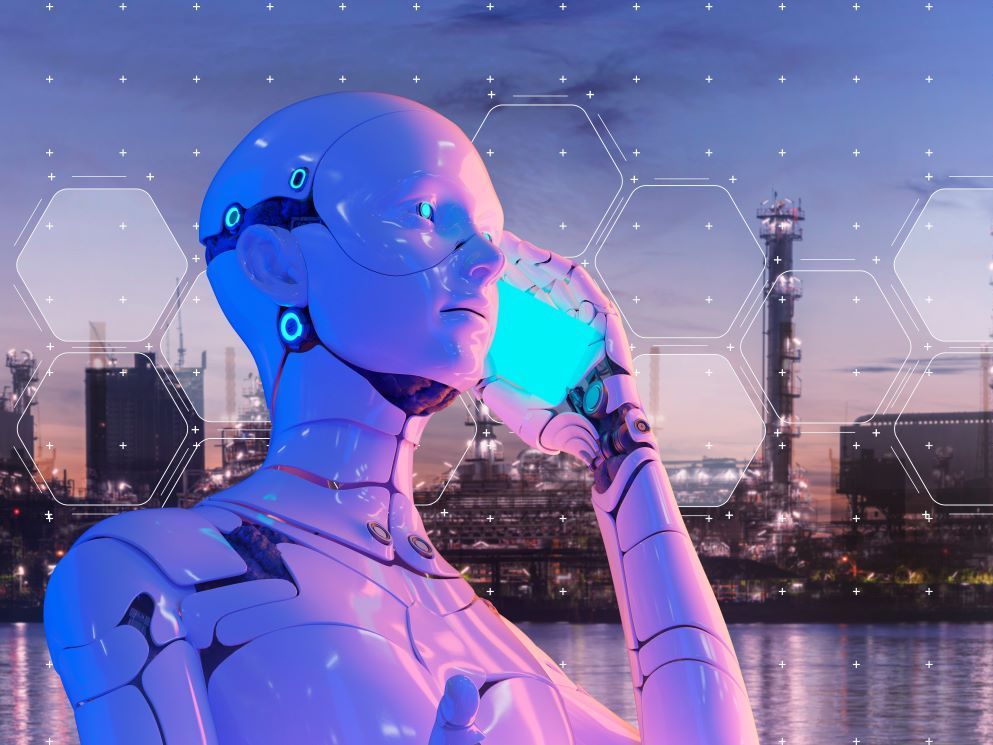“It is wholly a confusion of ideas to suppose that the economical use of fuel is equivalent to a diminished consumption. The very contrary is the truth.”
— William Stanley Jevons
The World Economic Forum has pronounced that artificial intelligence holds the “transformational potential” to fix our growing climate emergency.
AI can tell us how fast icebergs are melting. AI can map disappearing forests. AI can predict weather patterns in drought-stricken parts of Africa. AI can help sort through giant piles of waste materials and mine bits for recycling. AI can help companies trace, track and reduce their emissions by 20 per cent. AI can predict climate events such as floods, fires, hurricanes and other natural calamities so the global economy can continue on schedule.
And here’s the kicker. A “wish list of datasets,” assures the WEF, will eventually materialize “to advance global AI solutions for climate change.”
Plenty of other powerful voices are working hard to make us feel optimistic about a new society transformed by artificial intelligence.
By now, we really should know not to be taken in. For AI is but the latest manifestation of what the famed social critic Jacques Ellul called “the technological bluff.”
As repeated by the media and our politicians, the bluff claims that only technology will solve our problems. Remember how the internet was going to improve democracies and social media was going to foster a spirit of kumbaya?
The bluff pretends technology is a neutral force rather than one that concentrates power in fewer and fewer hands, replaces the natural with the artificial, turns every end into a means and has only one mandate: efficiency.
The bluff also requires that people be plunged hourly into a world of diversions and illusions. “It finally sucks us into this world by banishing all our ancient reservations and fears,” wrote Ellul 25 years ago in The Technological Bluff.
The bluff, of course, disparages the precautionary principle — the wisdom of slowing down and weighing risks when contemplating big changes in how we do things — as an irritating obstacle to progress.
But that wasn’t the message of a recent report issued by Greenpeace and five other environmental non-profits. “The AI Threats to Climate Change” calls the technological bluff by noting that artificial intelligence, the product of computing machines, will consume more energy and water and thereby add more chaos to the unravelling climate crisis.
AI will also make the exploitation of fossil fuels more efficient and thereby increase their consumption — already at record highs.
At the same time, AI’s language models will be manipulated by some to add more disinformation about climate change to the internet.
So far, a bracing and needed reality check from the report’s green authors. Unfortunately, however, they end up offering quite tepid recommendations.
They want digital tycoons to disclose the energy and water intensity of machine learning. OK, but why stop there? Why not force Big Tech to disclose the material intensity of all its digital products including cellphones, computers, data centres and electric cars?
Then the report suggests that the same techno barons who not only failed to care about the catastrophic effects of social media but torqued them for added profit should now provide us with “safe” and “accountable” AI.
How AI will hasten our energy and climate crises
However inadequate its conclusions, we at least can thank “The AI Threats to Climate Change” for highlighting what few proponents of AI want to admit. The carbon footprint of data centres, cables, satellite infrastructure and computing power required to drive AI is immense.
For the sake of brevity let’s reduce what is known about the hefty material appetites of AI from multiple sources (including “The AI Threats to Climate Change”) to four key points:
- AI gulps energy. One AI search burns 10 times as much energy as a routine Google search. According to researchers at the University of Washington, training a single large language model like ChatGPT-3 consumes the same amount of electricity as more than 1,000 U.S. households in a year. Hundreds of millions of daily queries just on ChatGPT consume one gigawatt hour of electricity each day. That is the equivalent of the daily energy consumption for about 33,000 U.S. households.
The AI tasks that consume the most energy and emit the most carbon are ones that include text generation, summarization, image captioning and image generation.
So AI represents a steep intensification of energy use in a world that needs to use less in a desperate race to avoid the collapse of civilization due to climate disasters.
In fact, the globe’s 8,000 data centres powering AI will soon consume as much energy as Japan. Some pessimistic scenarios suggest AI is on track to monopolize half of the world’s energy production by 2040. In Ireland, a high-tech hub, data centres could account for 32 per cent of all power consumption by 2026.
- High-tech firms typically offer little or no transparency on how their AI works and the carbon emissions of their products. Even as Big Tech claims it is making the world greener, at energy conferences the same companies fret that AI’s insatiable appetite for energy will drain grids and force greater dependency on natural gas, coal and nuclear energy.
- AI consumes large volumes of water, either in producing electricity to power computing systems or for the constant cooling that data servers require.
One Organization for Economic Co-operation and Development study estimates that global AI demand may even require 4.2 billion to 6.6 billion cubic metres of water withdrawal in 2027. That is equal to about half of the total annual water withdrawal of the United Kingdom.
- The oil and gas industry uses AI to produce more fossil fuels, more efficiently. For example, to improve drilling in the shale basins and to boost the recovery rates of fracked wells.
But all of this is only the tip of the iceberg. The French journalist Guillaume Pitron recently examined the full environmental cost of the digital economy in his extraordinary book The Dark Cloud (the French title, Digital Hell, is much more evocative).
His exposé found that the digital world gobbles up 10 per cent of the world’s electricity and represents more than four per cent of global emissions. That’s more than the civil aviation industry. Within a year or two it will account for 20 per cent of global electrical production and nearly eight per cent of greenhouse gas emissions.

Any time anyone sends an email, posts an image, streams a movie, orders by e-commerce or plays an electronic game, they have further revved a carbon-making machine. The material intensity of this machine keeps progressing at a startling rate. An analog phone in the 1960s needed but 10 elements to function. A modern cellphone requires 54 elements, including rare earth minerals. And all of that mining leaves a dirty carbon trail.
In fact, the digital world represents one of the largest material artifact humans have built on Earth. As Pitron relates, the global digital industry consumes enough water, material and energy to give it a footprint triple that of a country such as the United Kingdom. More than 34 billion pieces of digital equipment exist on the planet, weighing in total some 223 million tonnes.
Information and communication technology machines are the third-biggest consumer of energy after China and the United States. Remember that 35 per cent of the energy fuelling global electrical power plants is still coal-based.
When efficiency increases appetite
Pitron also notes that digital technologies have a dismal record of promising energy savings while cannibalizing energy supplies. Silicon Valley, for example, long championed connected metropolises or smart cities as a better way to conserve electricity and water with smart meters and smart sensors and smart appliances that talk. But when Danish researchers investigated the claims, they found that the high material and energy cost of these supposed technological helpers cancelled out any energy savings. They concluded that “Smart City Solutions generally has a negative influence on the environmental sustainability performance of an urban system.”
Nevertheless, the “very dirty” digital industry, as Pitron puts it, continues to rewrite the future. An industry group called the Global e-Sustainability Initiative, or GeSI, for instance, claims that the emissions avoided through the use of digital technology “are nearly 10 times greater than the emissions generated by deploying it.” Yet when Pitron investigated the claim, he found no science supporting it. It was and remains pure greenwashing. Or as one analyst explained: “It was so very appealing to believe that digital could generate economic growth and be good for the environment.”
So it is highly unlikely that AI, neither safe nor accountable, will solve our problems. As Pitron noted in a recent interview, “The idea of an eco-responsible AI justifies the resilience and development of the internet industry. But to believe that AI is the answer is to deny mankind this very possibility! Here we have a loss of trust in human nature and its ability to resolve the difficulties it has created.”

There is another issue consistently missed by most enviros and techno-optimists and that is the Jevons paradox. Simply put, whenever a society makes something more efficient or convenient, the energy or material savings are never saved because the efficiencies merely increase demand.
Jet planes may have been engineered to use less fuel, but these more efficient machines now carry more people than ever across the globe. Combustion cars are capable of using less gasoline than before, but any savings have disappeared in a raging market for heavier vehicles. Efficient windows and HVAC systems have saved energy in homes, but the gains disappear as homes get bigger and bigger. When high-tech data centres improve their energy efficiency, they store more data and therefore require ever more energy.
And so the claims made by AI proponents that machine learning will make the world more energy efficient offer no real solace.
That is true even if plans of replacing current levels of fossil fuel use with renewable energy can be achieved globally. U.S. engineer Peter Haff has observed that our commitment to inhabiting an ever-expanding “technosphere” of interlinked communication, transportation and administrative technologies will require more and more energy, placing an increasingly heavy demand on the planet. “The driving forces are already in place for transition to rates of energy consumption that are larger than, and perhaps much larger than, the current power level of fossil fuel use,” said Haff.
Nate Hagens, a social critic with an important podcast called The Great Simplification with Nate Hagens, doesn’t think AI will depart from this model. “AI is going to function as a larger straw, which is going to draw down our energy stocks faster, it’s going to draw down our ecosystem health faster, it’s going to act as a straw sucking from the bottom three-quarters of society towards the top,” he recently noted. “And my biggest fear of AI is not a biophysical thing, it’s a cultural human thing. My fear is that AI will act as a straw on our humanity.”
How to save ourselves
It may sound like the script for a science fiction movie, but some doomsayers ask us to imagine that at some point AI begins to act autonomously with pitiless logic. This conjures for Pitron and others the nightmare of a Green Leviathan.
What will happen if artificial intelligence begins to crunch certain numbers on climate change? They clearly show that the world’s top 10 per cent of emission makers, some 782 million people, come from Europe, North America, Japan, Korea, Australia, Russia and China. Globally, the top 10 per cent of emitters accounted for almost half of global energy-related carbon dioxide emissions in 2021, compared with a mere 0.2 per cent for the bottom 10 per cent. What will prevent a Green Leviathan from concluding that the fastest and most efficient way to reduce carbon emissions might be the elimination of these emitters?
So our technological conundrums cannot be divorced from our voracious energy demands as a species. There are imperfect solutions, but we don’t like any of them. We dislike them because they require shedding many technologies and their illusions.
“How appealing would ‘green’ seem if it meant less innovation and fewer cool gadgets — not more?” asked the U.S. writer David Owen in his excellent 2011 book The Conundrum.
The way forward, in other words, is to consciously take a step backwards. It means resisting the totality of the technological bluff.
It means divesting our homes of appliances and digital gadgets and celebrating the inconvenience of human industry.
It means embracing inconvenience and singing songs about the inefficiency of drying clothes on the line outside.
It means driving less and travelling less.
It means conservation as opposed to efficiency.
It means favouring quality over quantity.
It means rewarding durability over obsolescence.
It means going slow instead of fast and rejecting the siren of growth.
It means supplanting data with traditional wisdom.
And it means actively working towards a simplification of civilization as opposed to a chaotic complexity that only unaccountable AI robots can manage.
Lastly, it means beating a sustainable retreat from the digital economy and the menace of AI. ![]()
Read more: Energy, Environment

















Tyee Commenting Guidelines
Comments that violate guidelines risk being deleted, and violations may result in a temporary or permanent user ban. Maintain the spirit of good conversation to stay in the discussion and be patient with moderators. Comments are reviewed regularly but not in real time.
Do:
Do not: